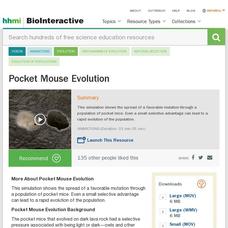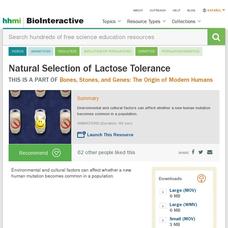Nature League
Exploring Evolution and Speciation - Lesson Plan
The first video in a five-part series on Evolution and Speciation introduces four types of evolution and addresses common misconceptions. In addition, viewers learn about topics current understanding of science does not fully explain.
Howard Hughes Medical Institute
Pocket Mouse and Predation
The rock pocket mouse exists either with light colored or dark colored fur. As their habitat changes from sandy desert to lava flows the prominence of each color fur also changes. Viewers compare the visibility of each mouse's fur color...
Nature League
What Are Adaptations? - Lesson Plan
Texas short-horned lizards shoot blood out of their eyes to deter predators. The unique adaption allows them to thrive in a hostile environment. Pupils learn more about this and other adaptations of plants, animals, and humans in the...
Crash Course
Eugenics and Francis Galton: Crash Course History of Science #23
Viewers l earn about the rise and fall of social Darwinism, eugenics, and flawed science during the 23rd episode of the Crash Course History of Science video series. The video covers if awesomeness is hereditary, the invention of birth...
Crash Course
Darwin and Natural Selection: Crash Course History of Science #22
Charles Darwin studied many species, but he also hindered their continued study by eating his specimens. Like many sailors, he enjoyed the taste of the Galapagos tortoise so much for many years that no ship made it all the way back to...
Howard Hughes Medical Institute
Pocket Mouse Evolution
G.H. Hardy and Wilhelm Weinberg created a mathematical formula to predict genotype frequencies. Observe a simulation of the Hardy-Weinberg equation using pocket mice. Scholars consider the selection coefficient, selective advantage, and...
Howard Hughes Medical Institute
Natural Selection of Lactose Tolerance
Different regions of the world have greatly varying rates of lactose tolerance. Learn why this mutation spreads in some populations and not others with an educational video. Viewers consider the relationship with natural selection in...
Be Smart
Tuatara All the Way Down: Face to Face with a Living Fossil!
Change is good ... unless you're a tuatara! Meet Earth's oldest surviving reptile species in a fun video from an extensive science playlist. Content includes why the tuatara did not evolve and its unique anatomy.
Be Smart
Why Are There as Many Males as Females?
From anteaters to zebras, why are both sexes equally represented in number? Explore a quirk in evolution with a video from a thought-provoking science playlist. The narrator shows examples of species that might only need a few males,...
Be Smart
Where Did Life Come From?
Just when you thought you had life figured out ... here comes another great video! Young biologists discover the multi-faceted meaning of life through a video from a comprehensive science playlist. Content includes when life appeared on...
Be Smart
How Evolution Turned a Possum into a Wolf
Do bats really have thumbs? Explore this, and many other intriguing topics using a short video from a great science series. Viewers learn to differentiate between analogous and homologous structures, why natural selection favors traits...
Howard Hughes Medical Institute
Anole Lizards: An Example of Speciation
What happens to a species when members become separated by changes in their environment? Present young biologists with the ultimate example species—the anole lizard. A brief video describes the origins of the multitude of anole species...
PBS
Evolution 101
Have you been shaped by evolution? A short video introduces the idea of evolution through examples of natural selection, reproduction, traits, and more. The video exists as a small part of a series from the NOVA Evolution Lab.
Howard Hughes Medical Institute
Natural Selection and Adaptation
It's not every day that you end up rooting for a mouse. A breathtaking video takes scholars to the American Southwest to learn about the rock pocket mouse. It describes how mice with black fur had an evolutionary advantage in the dark...
Amoeba Sisters
Genetic Drift
Survival is a game of chance, catch my drift? Examine the factors that influence genetic drift with an entertaining video from a large biology playlist. The resource covers the myriad conditions that come into play when a species...
Amoeba Sisters
Speciation
Why can't mules have babies? Answer this—and other burning animal kingdom mysteries—with a short, sweet speciation video! Zoology scholars examine the ins and out of evolution, the role geography plays in inheritable traits, and, most of...
PBS
How Sex Became a Thing
Birds, bees, flowers, trees ... and Funisia dorothea? Biology scholars journey back in time to discover more about the history of sexual reproduction. The video, one of many in a biology playlist, covers our earliest eukaryotic ancestor,...
Veritasium
Evolutionarily Stable Strategies ft. Richard Dawkins
What makes one animal better suited to its environment than another? Explore the concept of evolutionarily stable strategies with a video from Veritasium. Biologist Richard Dawkins explains how behavioral traits become predominant in a...
FuseSchool
Evolution by Natural Selection
Bird is the word! Young biologists discover how the tiny finch changed the way scientists viewed evolution and changes in species using a fascinating video from Fuse School's Evolution playlist. The narrator describes Darwin's...
FuseSchool
Evidence for Natural Selection
What evidence is there for natural selection? Science sleuths examine the facts using an animated Fuse School video as part of the Evolution playlist. Content includes fossil records, physical similarities, and differences in...
FuseSchool
Competition and Natural Selection
How does competition for resources influence natural selection? Only those that thrive survive! An intriguing video in the Fuse School Evolution playlist demonstrates how survival of the fittest ultimately decides the fate of a species....
FuseSchool
Mutations and Natural Selection
Mutations have a bad reputation ... but are they always harmful? Junior geneticists explore mutations and their effects in a Fuse School Evolution video. The content features sickle cell disease, its effects on the body, and its ability...
FuseSchool
Charles Darwin's Observations
How did Charles Darwin become one of the most recognized names in biology? Introduce young naturalists to the early history of Darwin using a brief Fuse School Evolution video. The narrator discusses Darwin's beginnings as a theology...
Crash Course
The Evolutionary Epic: Crash Course Big History #5
In the timeline of history, Stegosaurus and Tyrannosaurus rex lived further apart from each other than Tyrannosaurus rex and humans. The fifth Crash Course-Big History video in a series of 16 introduces the concept of evolution. It...























